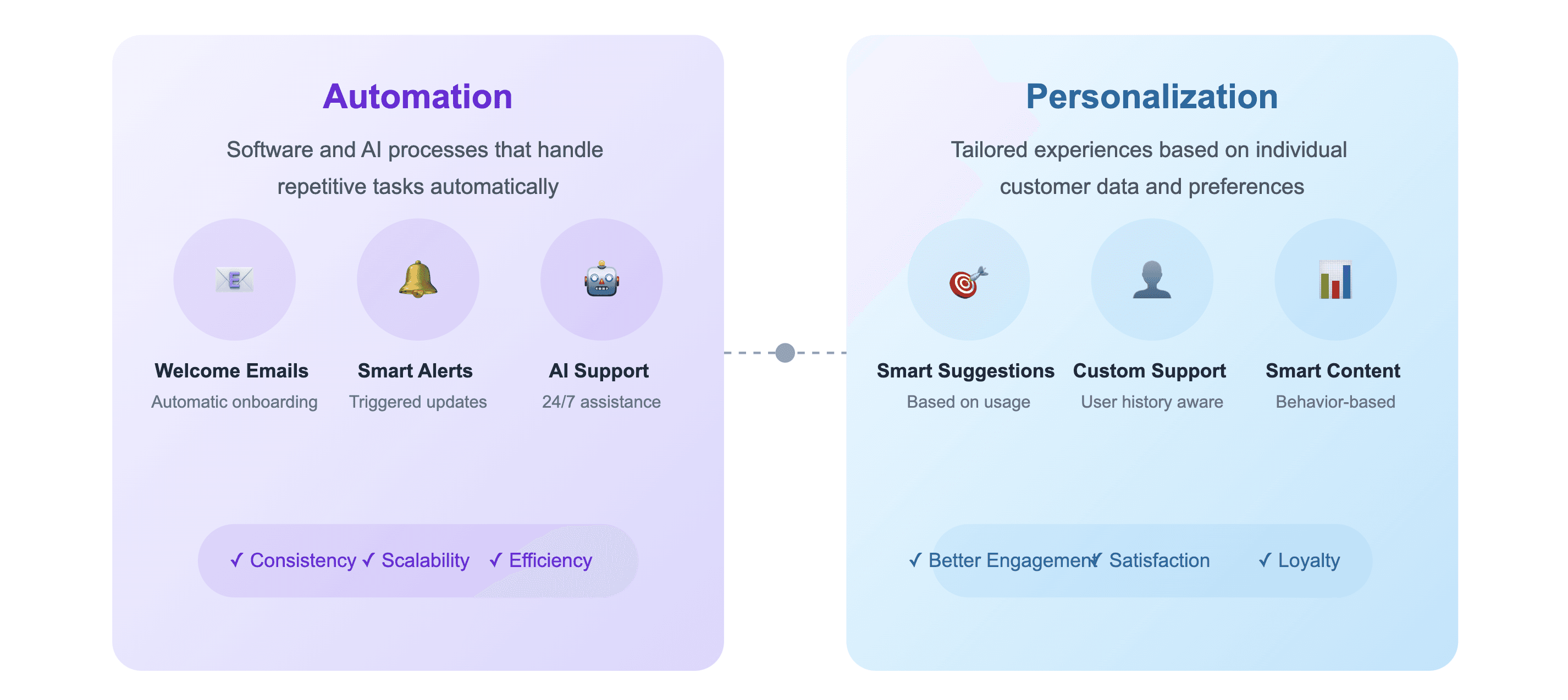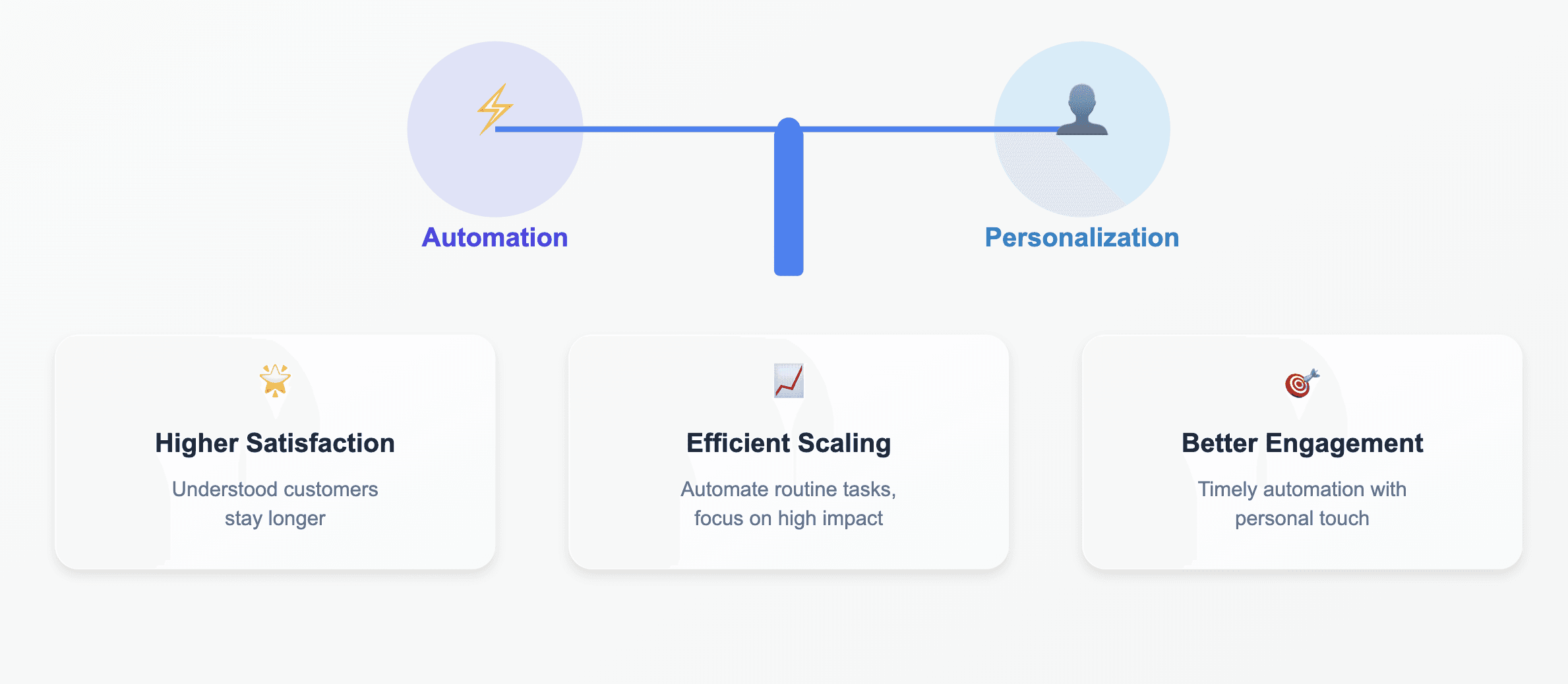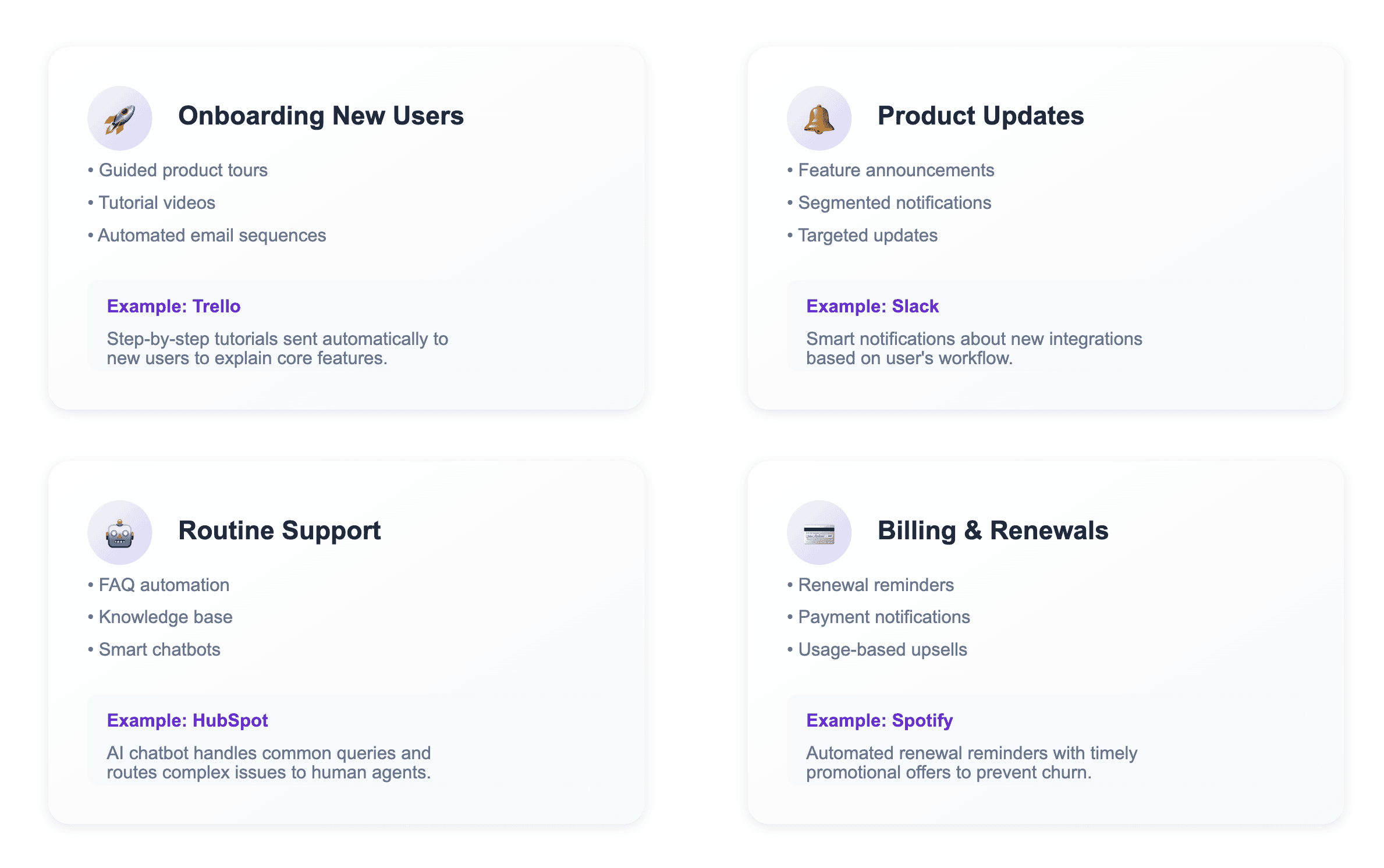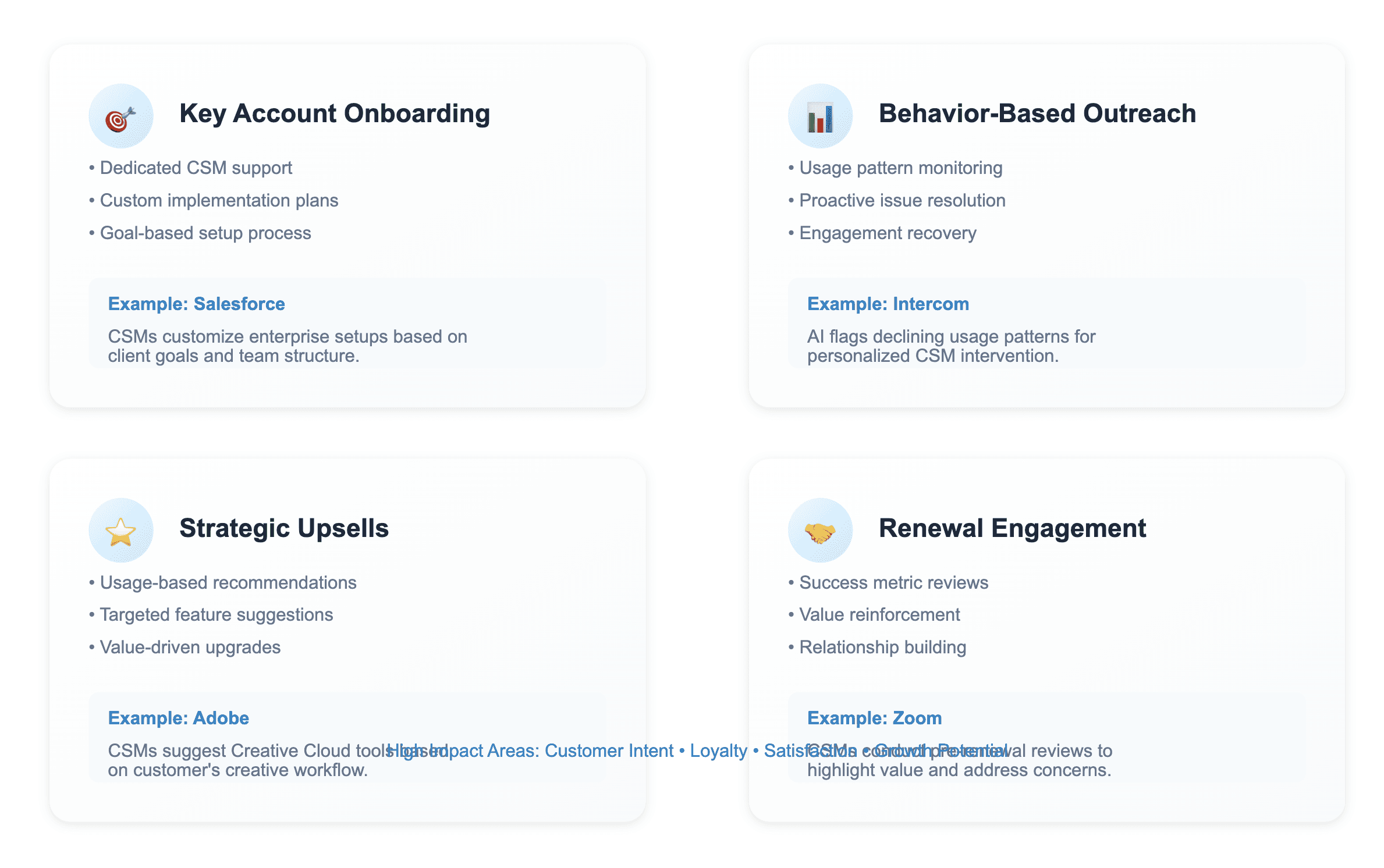
Automation and Personalization in SaaS Customer Touchpoints

by
Wiktoria Slowikowska
Nov 6, 2024
Identify and convert your most valuable users
Sign Up
Every interaction with a customer is an opportunity to reinforce your brand, solve problems, or drive a customer closer to conversion or retention. But with growing user bases and increasingly complex customer journeys, it’s tempting to automate every touchpoint for efficiency and scalability.
However, what customers often value most is a personalized experience that shows you care about their specific needs. The challenge lies in striking a balance between automation and personalization.
This article dives deep into when SaaS companies should automate customer touchpoints versus when they should invest in personalized engagement. We’ll explore the benefits of each approach, offer examples, and provide actionable guidance to help you maximize customer satisfaction, loyalty, and revenue.
1. Understanding Automation and Personalization in Customer Touchpoints

Automation refers to the use of software and artificial intelligence (AI) to streamline repetitive tasks, ensuring consistency, scalability, and often saving costs. Examples include automated welcome emails, triggered notifications for product updates, and AI-driven customer support chatbots.
Personalization involves tailoring communications, product recommendations, or customer support experiences based on specific customer data, behaviors, and preferences. Personalized interactions go beyond generic messaging to show customers that their individual needs and goals matter.
2. Why the Balance Matters in SaaS

SaaS companies typically cater to a diverse range of customers, each with unique goals, timelines, and engagement levels. An all-automated approach might feel efficient, but it can risk alienating customers who crave human connection, especially in moments that matter most to them. Conversely, attempting to personalize every interaction can be costly and unsustainable as the user base grows.
Achieving the right balance can lead to:
Higher customer satisfaction and loyalty: Customers who feel understood and valued are more likely to stay.
Efficient scalability: By automating the right touchpoints, teams can focus resources on high-impact, personalized interactions.
Improved product adoption and engagement: Automation can ensure customers receive timely information, while personalization can address specific adoption challenges.
3. When to Automate Customer Touchpoints

Automation shines in areas where consistency and speed are crucial, especially for high-frequency, low-complexity interactions. Here’s when automation makes the most sense:
Onboarding New Users
Automation can streamline the onboarding process through guided tours, tutorial videos, and automated email sequences. For instance, automated check-in emails can offer new users helpful resources without overwhelming them.
Example: A SaaS tool like Trello sends automated, step-by-step tutorials to new users. These guides explain core features and encourage users to take simple actions, allowing users to learn at their own pace.
Product Updates and Feature Announcements
Automated notifications for product updates and feature announcements keep users informed without requiring manual outreach. Triggered announcements based on user segments (e.g., those who use specific features) add relevancy while remaining automated.
Example: Slack uses in-app notifications to alert users about updates relevant to their workflow. An automated announcement about a new integration for Google Calendar appears only to users who use Slack and Google Calendar together, adding relevance without the need for individual outreach.
Routine Customer Support Inquiries
Not every question requires a human response, especially common queries that can be resolved quickly with FAQs, knowledge bases, or chatbots.
Example: HubSpot’s chatbot instantly assists customers with routine questions about pricing or product features. For more complex needs, the bot routes users to a human support agent.
Renewal Reminders and Billing Notifications
Automated billing and renewal notifications are essential to avoid lapses in service. These touchpoints keep customers informed of their subscription status and can include upsell prompts based on usage.
Example: Spotify sends automated renewal reminders and offers additional promotions to customers nearing their subscription expiration date, prompting them to renew before service is disrupted.
4. When to Personalize Customer Touchpoints

Personalization should be reserved for high-impact touchpoints where customer intent, loyalty, or satisfaction is at stake. Here’s when personalization has the biggest impact:
High-Touch Onboarding for Key Accounts
For high-value or enterprise clients, a generic onboarding won’t cut it. A dedicated customer success manager (CSM) can personalize the onboarding to address specific goals, challenges, and use cases.
Example: Salesforce assigns a CSM to its enterprise clients who customizes the setup process based on the client’s goals and team structure. This personal touch helps larger accounts see the value of their investment early on.
Proactive Outreach Based on Customer Behavior
Behavioral triggers are key indicators of where personalized support may be needed. For example, if a user hasn’t logged in for several weeks, a personalized check-in from a CSM can re-engage them.
Example: Intercom uses AI to flag customers with declining usage patterns, triggering personalized outreach from CSMs to understand any challenges and provide solutions. This approach helps boost retention by proactively addressing issues before they lead to churn.
Upsell and Cross-Sell Opportunities
Tailoring product recommendations to specific customer needs can increase the chances of upselling. By reviewing usage data, customer success teams can recommend add-ons or upgrades that fit naturally with the customer’s usage.
Example: Adobe monitors usage patterns in its Creative Cloud suite, allowing CSMs to suggest additional software that aligns with a customer’s creative projects, offering personalized recommendations that directly meet user needs.
Renewal and Retention Strategies
When it comes to renewals, personalized engagement can help customers see the value they’ve received and highlight new ways to use the product. CSMs can review the customer’s usage and success metrics, reinforcing how the product has supported their goals.
Example: Zoom’s CSMs reach out to enterprise clients before renewal to review usage data and address any challenges. This high-touch approach builds rapport, ensuring clients are satisfied with the product before renewal.
5. Building a Seamless Automation-Personalization Strategy

Balancing automation and personalization is about creating a seamless customer experience that feels efficient but also considerate. Here’s a step-by-step approach to crafting a successful strategy:
Map the Customer Journey
Identify critical touchpoints across the customer lifecycle, from acquisition to retention. Understanding the journey helps pinpoint when automation can enhance efficiency and when personal engagement is necessary to drive value.
Segment Your Customers
Use segmentation to identify customer types that would benefit more from personalization (e.g., enterprise accounts, long-time users) versus those where automation may be enough (e.g., trial users, smaller accounts).
Leverage Data and Analytics
Behavioral analytics and usage data can signal when personalized intervention is needed. If data shows a drop in engagement, prompt a personalized touchpoint. Conversely, if users are highly engaged, automated upsell suggestions can be effective.
Test and Iterate
Continuously test different approaches to understand what works best for each touchpoint. Experiment with automating a touchpoint and then compare it with a personalized approach to assess the impact on user satisfaction, engagement, and conversion rates.
6. Finding Your Balance
Automation and personalization both play crucial roles. Automation helps companies scale efficiently, delivering timely and relevant information without overwhelming resources. Personalization, however, demonstrates empathy, strengthens relationships, and reassures customers that they’re more than just an account number.
By understanding when to automate versus personalize, SaaS companies can create an experience that feels both seamless and genuine. Not only will this balanced approach foster customer loyalty, but it will also support sustainable growth, helping your business stand out in a competitive landscape.
Striking the perfect balance isn’t easy, but with careful planning, data-driven insights, and a deep understanding of your customers’ needs, you can craft a customer journey that enhances satisfaction, promotes retention, and powers long-term success.
By focusing on the right mix of automation and personalization, SaaS companies can elevate their customer touchpoints, ensuring each interaction not only serves a purpose but also leaves a positive impact.





